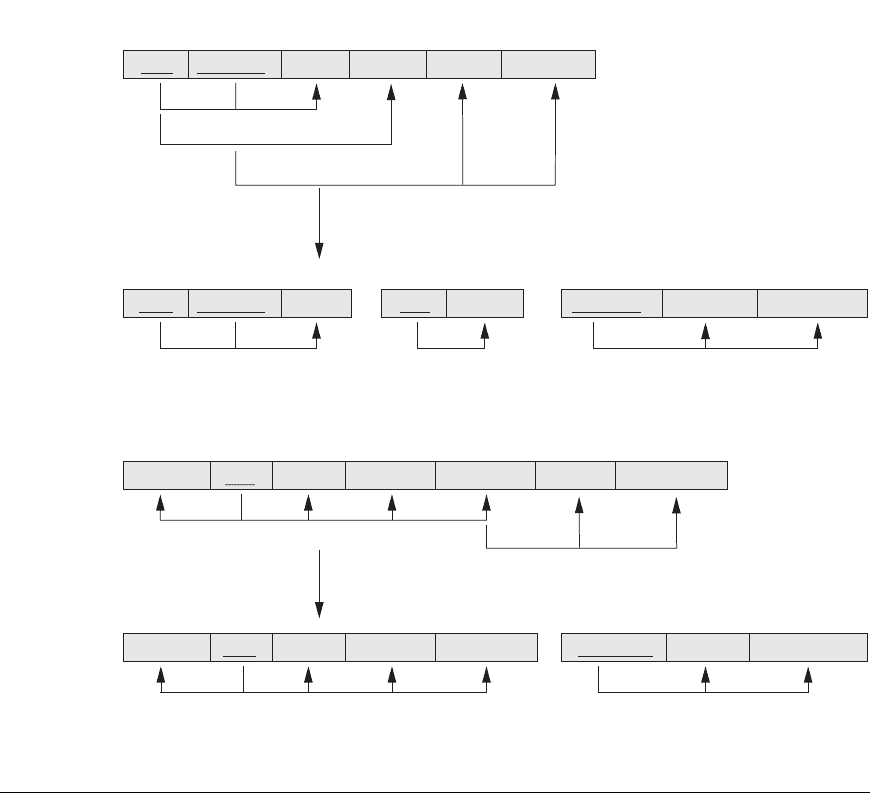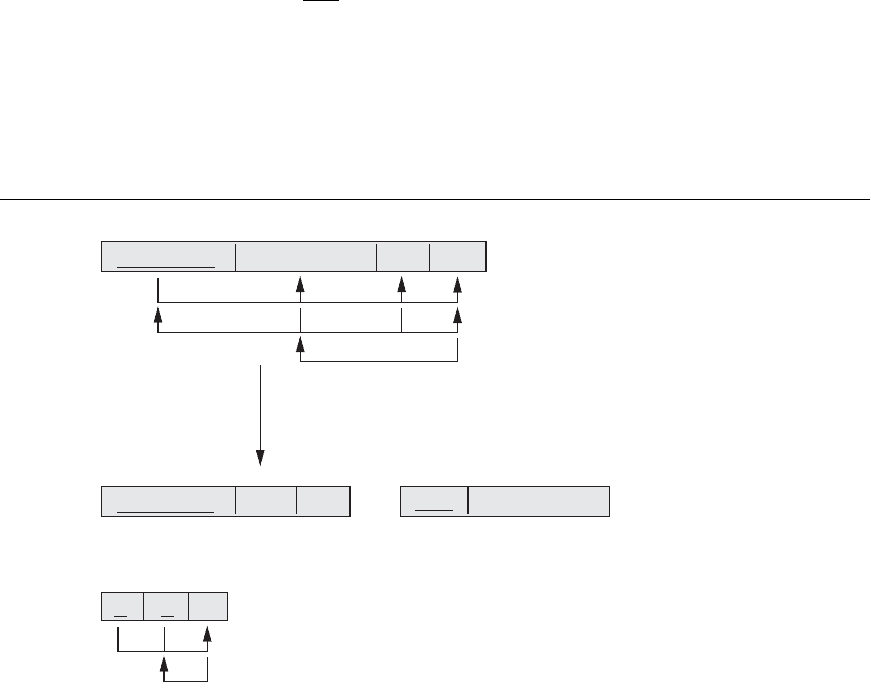Elmasri R., Navathe S.B. Fundamentals of Database Systems
Подождите немного. Документ загружается.


522 Chapter 15 Basics of Functional Dependencies and Normalization for Relational Databases
EMP_PROJ
(a)
Projs
Pnumber HoursSsn Ename
EMP_PROJ1
(c)
Ssn Ename
EMP_PROJ2
Hours
Ssn Pnumber
EMP_PROJ
(b)
Ssn
123456789
666884444
453453453
333445555
999887777
987987987
987654321
888665555
Zelaya, Alicia J.
Jabbar, Ahmad V.
Wallace, Jennifer S.
Borg, James E.
32.5
7.5
40.0
20.0
20.0
10.0
10.0
10.0
10.0
30.0
10.0
35.0
5.0
20.0
15.0
NULL
English, Joyce A.
Narayan, Ramesh K.
Smith, John B.
Wong, Franklin T.
Ename
3
1
2
1
2
2
20
3
10
30
10
10
20
30
30
20
Pnumber Hours
Figure 15.10
Normalizing nested rela-
tions into 1NF. (a)
Schema of the
EMP_PROJ relation with
a nested relation attribute
PROJS. (b) Sample
extension of the
EMP_PROJ relation
showing nested relations
within each tuple. (c)
Decomposition of
EMP_PROJ into relations
EMP_PROJ1 and
EMP_PROJ2 by propa-
gating the primary key.
existence of more than one multivalued attribute in one relation must be handled
carefully. As an example, consider the following non-1NF relation:
PERSON (Ss#,{Car_lic#}, {Phone#})
This relation represents the fact that a person has multiple cars and multiple
phones. If strategy 2 above is followed, it results in an all-key relation:
PERSON_IN_1NF (Ss#, Car_lic#, Phone#)

15.3 Normal Forms Based on Primary Keys 523
To avoid introducing any extraneous relationship between Car_lic# and Phone#,all
possible combinations of values are represented for every
Ss#, giving rise to redun-
dancy. This leads to the problems handled by multivalued dependencies and 4NF,
which we will discuss in Section 15.6. The right way to deal with the two multival-
ued attributes in
PERSON shown previously is to decompose it into two separate
relations, using strategy 1 discussed above:
P1(Ss#, Car_lic#) and P2(Ss#, Phone#).
15.3.5 Second Normal Form
Second normal form (2NF) is based on the concept of full functional dependency. A
functional dependency X → Y is a full functional dependency if removal of any
attribute A from X means that the dependency does not hold any more; that is, for
any attribute A ε X,(X – {A}) does not functionally determine Y. A functional
dependency X → Y is a partial dependency if some attribute A ε X can be removed
from X and the dependency still holds; that is, for some A ε X,(X – {A}) → Y.In
Figure 15.3(b), {
Ssn, Pnumber} → Hours is a full dependency (neither Ssn → Hours
nor Pnumber → Hours holds). However, the dependency {Ssn, Pnumber} → Ename is
partial because
Ssn → Ename holds.
Definition. A relation schema R is in 2NF if every nonprime attribute A in R is
fully functionally dependent on the primary key of R.
The test for 2NF involves testing for functional dependencies whose left-hand side
attributes are part of the primary key. If the primary key contains a single attribute,
the test need not be applied at all. The
EMP_PROJ relation in Figure 15.3(b) is in
1NF but is not in 2NF. The nonprime attribute
Ename violates 2NF because of FD2,
as do the nonprime attributes
Pname and Plocation because of FD3. The functional
dependencies
FD2 and FD3 make Ename, Pname, and Plocation partially dependent
on the primary key {
Ssn, Pnumber} of EMP_PROJ, thus violating the 2NF test.
If a relation schema is not in 2NF, it can be second normalized or 2NF normalized
into a number of 2NF relations in which nonprime attributes are associated only
with the part of the primary key on which they are fully functionally dependent.
Therefore, the functional dependencies
FD1, FD2, and FD3 in Figure 15.3(b) lead to
the decomposition of
EMP_PROJ into the three relation schemas EP1, EP2, and EP3
shown in Figure 15.11(a), each of which is in 2NF.
15.3.6 Third Normal Form
Third normal form (3NF) is based on the concept of transitive dependency.A
functional dependency X → Y in a relation schema R is a transitive dependency if
there exists a set of attributes Z in R that is neither a candidate key nor a subset of
any key of R,
10
and both X → Z and Z → Y hold. The dependency Ssn → Dmgr_ssn
is transitive through Dnumber in EMP_DEPT in Figure 15.3(a), because both the
10
This is the general definition of transitive dependency. Because we are concerned only with primary
keys in this section, we allow transitive dependencies where X is the primary key but Z may be (a subset
of) a candidate key.

524 Chapter 15 Basics of Functional Dependencies and Normalization for Relational Databases
Ssn
EMP_PROJ
(a)
(b)
FD1
FD2
FD3
2NF Normalization
Pnumber Hours Ename Pname Plocation
Ssn
EP1
FD1
Pnumber Hours
Ename Ssn
ED1
Bdate Address Dnumber
Ssn
EP2
FD2
Ename Pnumber
EP3
FD3
Pname Plocation
Ename Ssn
EMP_DEPT
Bdate Address Dnumber Dname Dmgr_ssn
Dnumber
ED2
Dname Dmgr_ssn
3NF Normalization
Figure 15.11
Normalizing into 2NF and 3NF. (a) Normalizing EMP_PROJ into
2NF relations. (b) Normalizing EMP_DEPT into 3NF relations.
dependencies Ssn → Dnumber and Dnumber → Dmgr_ssn hold and Dnumber is nei-
ther a key itself nor a subset of the key of
EMP_DEPT. Intuitively, we can see that
the dependency of
Dmgr_ssn on Dnumber is undesirable in EMP_DEPT since
Dnumber is not a key of EMP_DEPT.
Definition. According to Codd’s original definition, a relation schema R is in
3NF if it satisfies 2NF and no nonprime attribute of R is transitively dependent
on the primary key.
The relation schema
EMP_DEPT in Figure 15.3(a) is in 2NF, since no partial depen-
dencies on a key exist. However,
EMP_DEPT is not in 3NF because of the transitive
dependency of
Dmgr_ssn (and also Dname) on Ssn via Dnumber. We can normalize

15.4 General Definitions of Second and Third Normal Forms 525
Table 15.1 Summary of Normal Forms Based on Primary Keys and Corresponding Normalization
Normal Form Test Remedy (Normalization)
First (1NF) Relation should have no multivalued
attributes or nested relations.
Form new relations for each multivalued
attribute or nested relation.
Second (2NF) For relations where primary key con-
tains multiple attributes, no nonkey
attribute should be functionally
dependent on a part of the primary key.
Decompose and set up a new relation for
each partial key with its dependent attrib-
ute(s). Make sure to keep a relation with
the original primary key and any attributes
that are fully functionally dependent on it.
Third (3NF) Relation should not have a nonkey
attribute functionally determined by
another nonkey attribute (or by a set of
nonkey attributes). That is, there should
be no transitive dependency of a non-
key attribute on the primary key.
Decompose and set up a relation that
includes the nonkey attribute(s) that func-
tionally determine(s) other nonkey attrib-
ute(s).
EMP_DEPT by decomposing it into the two 3NF relation schemas ED1 and ED2
shown in Figure 15.11(b). Intuitively, we see that ED1 and ED2 represent independ-
ent entity facts about employees and departments. A
NATURAL JOIN operation on
ED1 and ED2 will recover the original relation EMP_DEPT without generating spu-
rious tuples.
Intuitively, we can see that any functional dependency in which the left-hand side is
part (a proper subset) of the primary key, or any functional dependency in which
the left-hand side is a nonkey attribute, is a problematic FD. 2NF and 3NF normal-
ization remove these problem FDs by decomposing the original relation into new
relations. In terms of the normalization process, it is not necessary to remove the
partial dependencies before the transitive dependencies, but historically, 3NF has
been defined with the assumption that a relation is tested for 2NF first before it is
tested for 3NF. Table 15.1 informally summarizes the three normal forms based on
primary keys, the tests used in each case, and the corresponding remedy or normal-
ization performed to achieve the normal form.
15.4 General Definitions of Second
and Third Normal Forms
In general, we want to design our relation schemas so that they have neither partial
nor transitive dependencies because these types of dependencies cause the update
anomalies discussed in Section 15.1.2. The steps for normalization into 3NF rela-
tions that we have discussed so far disallow partial and transitive dependencies on
the primary key. The normalization procedure described so far is useful for analysis
in practical situations for a given database where primary keys have already been
defined. These definitions, however, do not take other candidate keys of a relation, if

526 Chapter 15 Basics of Functional Dependencies and Normalization for Relational Databases
any, into account. In this section we give the more general definitions of 2NF and
3NF that take all candidate keys of a relation into account. Notice that this does not
affect the definition of 1NF since it is independent of keys and functional depen-
dencies. As a general definition of prime attribute, an attribute that is part of any
candidate key will be considered as prime. Partial and full functional dependencies
and transitive dependencies will now be considered with respect to all candidate keys
of a relation.
15.4.1 General Definition of Second Normal Form
Definition. A relation schema R is in second normal form (2NF) if every non-
prime attribute A in R is not partially dependent on any key of R.
11
The test for 2NF involves testing for functional dependencies whose left-hand side
attributes are part of the primary key. If the primary key contains a single attribute,
the test need not be applied at all. Consider the relation schema
LOTS shown in
Figure 15.12(a), which describes parcels of land for sale in various counties of a
state. Suppose that there are two candidate keys:
Property_id# and {County_name,
Lot#}; that is, lot numbers are unique only within each county, but Property_id#
numbers are unique across counties for the entire state.
Based on the two candidate keys
Property_id# and {County_name, Lot#}, the func-
tional dependencies
FD1 and FD2 in Figure 15.12(a) hold. We choose Property_id# as
the primary key, so it is underlined in Figure 15.12(a), but no special consideration
will be given to this key over the other candidate key. Suppose that the following two
additional functional dependencies hold in
LOTS:
FD3: County_name → Tax_rate
FD4: Area → Price
In words, the dependency FD3 says that the tax rate is fixed for a given county (does
not vary lot by lot within the same county), while
FD4 says that the price of a lot is
determined by its area regardless of which county it is in. (Assume that this is the
price of the lot for tax purposes.)
The
LOTS relation schema violates the general definition of 2NF because Tax_rate is
partially dependent on the candidate key {
County_name, Lot#}, due to FD3. To nor-
malize
LOTS into 2NF, we decompose it into the two relations LOTS1 and LOTS2,
shown in Figure 15.12(b). We construct
LOTS1 by removing the attribute Tax_rate
that violates 2NF from LOTS and placing it with County_name (the left-hand side of
FD3 that causes the partial dependency) into another relation LOTS2. Both LOTS1
and LOTS2 are in 2NF. Notice that FD4 does not violate 2NF and is carried over to
LOTS1.
11
This definition can be restated as follows: A relation schema R is in 2NF if every nonprime attribute A
in R is fully functionally dependent on every key of R.

15.4 General Definitions of Second and Third Normal Forms 527
Property_id#
LOTS
(a)
FD1
FD2
FD3
FD4
County_name Lot# Area
Price Tax_rate
Property_id#
LOTS1
(b)
FD1
FD2
FD4
County_name Lot# Area
Price
(c)
(d)
Property_id#
LOTS1A
FD1
FD2
County_name Lot# Area
LOTS2
FD3
County_name
Tax_rate
LOTS1B
FD4
Area Price
LOTS 1NF
LOTS1
LOTS1A LOTS1B
LOTS2 2NF
LOTS2 3NF
Candidate Key
Figure 15.12
Normalization into 2NF and 3NF. (a) The LOTS relation with its functional dependencies
FD1 through FD4. (b) Decomposing into the 2NF relations LOTS1 and LOTS2. (c)
Decomposing LOTS1 into the 3NF relations LOTS1A and LOTS1B. (d) Summary of the
progressive normalization of LOTS.
528 Chapter 15 Basics of Functional Dependencies and Normalization for Relational Databases
15.4.2 General Definition of Third Normal Form
Definition. A relation schema R is in third normal form (3NF) if, whenever a
nontrivial functional dependency X → A holds in R, either (a) X is a superkey of
R, or (b) A is a prime attribute of R.
According to this definition,
LOTS2 (Figure 15.12(b)) is in 3NF. However, FD4 in
LOTS1 violates 3NF because Area is not a superkey and Price is not a prime attribute
in
LOTS1. To normalize LOTS1 into 3NF, we decompose it into the relation schemas
LOTS1A and LOTS1B shown in Figure 15.12(c). We construct LOTS1A by removing
the attribute
Price that violates 3NF from LOTS1 and placing it with Area (the left-
hand side of
FD4 that causes the transitive dependency) into another relation
LOTS1B. Both LOTS1A and LOTS1B are in 3NF.
Two points are worth noting about this example and the general definition of 3NF:
■
LOTS1 violates 3NF because Price is transitively dependent on each of the
candidate keys of
LOTS1 via the nonprime attribute Area.
■
This general definition can be applied directly to test whether a relation
schema is in 3NF; it does not have to go through 2NF first. If we apply the
above 3NF definition to
LOTS with the dependencies FD1 through FD4,we
find that both
FD3 and FD4 violate 3NF. Therefore, we could decompose
LOTS into LOTS1A, LOTS1B, and LOTS2 directly. Hence, the transitive and
partial dependencies that violate 3NF can be removed in any order.
15.4.3 Interpreting the General Definition
of Third Normal Form
A relation schema R violates the general definition of 3NF if a functional depen-
dency X → A holds in R that does not meet either condition—meaning that it vio-
lates both conditions (a) and (b) of 3NF. This can occur due to two types of
problematic functional dependencies:
■
A nonprime attribute determines another nonprime attribute. Here we typ-
ically have a transitive dependency that violates 3NF.
■
A proper subset of a key of R functionally determines a nonprime attribute.
Here we have a partial dependency that violates 3NF (and also 2NF).
Therefore, we can state a general alternative definition of 3NF as follows:
Alternative Definition. A relation schema R is in 3NF if every nonprime attribute
of R meets both of the following conditions:
■
It is fully functionally dependent on every key of R.
■
It is nontransitively dependent on every key of R.

15.5 Boyce-Codd Normal Form 529
Property_id#
LOTS1A(a)
(b)
FD1
FD2
FD1
FD2
FD5
BCNF Normalization
County_name Lot# Area
Property_id#
LOTS1AX
Area Lot#
A
R
BC
Area
LOTS1AY
County_name
Figure 15.13
Boyce-Codd normal form. (a) BCNF
normalization of LOTS1A with the func-
tional dependency FD2 being lost in
the decomposition. (b) A schematic
relation with FDs; it is in 3NF, but not
in BCNF.
15.5 Boyce-Codd Normal Form
Boyce-Codd normal form (BCNF) was proposed as a simpler form of 3NF, but it
was found to be stricter than 3NF. That is, every relation in BCNF is also in 3NF;
however, a relation in 3NF is not necessarily in BCNF. Intuitively, we can see the need
for a stronger normal form than 3NF by going back to the
LOTS relation schema in
Figure 15.12(a) with its four functional dependencies
FD1 through FD4. Suppose
that we have thousands of lots in the relation but the lots are from only two coun-
ties: DeKalb and Fulton. Suppose also that lot sizes in DeKalb County are only 0.5,
0.6, 0.7, 0.8, 0.9, and 1.0 acres, whereas lot sizes in Fulton County are restricted to
1.1, 1.2, ..., 1.9, and 2.0 acres. In such a situation we would have the additional func-
tional dependency
FD5: Area → County_name. If we add this to the other dependen-
cies, the relation schema
LOTS1A still is in 3NF because County_name is a prime
attribute.
The area of a lot that determines the county, as specified by
FD5, can be represented
by 16 tuples in a separate relation R(
Area, County_name), since there are only 16 pos-
sible
Area values (see Figure 15.13). This representation reduces the redundancy of
repeating the same information in the thousands of
LOTS1A tuples. BCNF is a
stronger normal form that would disallow
LOTS1A and suggest the need for decom-
posing it.
Definition. A relation schema R is in BCNF if whenever a nontrivial functional
dependency X → A holds in R, then X is a superkey of R.

530 Chapter 15 Basics of Functional Dependencies and Normalization for Relational Databases
TEACH
Student
Na
rayan
Smith
Smith
Smith
Mark
Navathe
Ammar
Schulman
Operating Systems
Database
Database
Theory
Wallace
Wallace
Wong
Zelaya
Mark
Ahamad
Omiecinski
Navathe
Database
Database
Operating Systems
Database
Cou
rse Instructor
Narayan
Operating Systems
Ammar
Figure 15.14
A relation TEACH that is in
3NF but not BCNF.
The formal definition of BCNF differs from the definition of 3NF in that condition
(b) of 3NF, which allows A to be prime, is absent from BCNF. That makes BCNF a
stronger normal form compared to 3NF. In our example,
FD5 violates BCNF in
LOTS1A because AREA is not a superkey of LOTS1A. Note that FD5 satisfies 3NF in
LOTS1A because County_name is a prime attribute (condition b), but this condition
does not exist in the definition of BCNF. We can decompose
LOTS1A into two BCNF
relations
LOTS1AX and LOTS1AY, shown in Figure 15.13(a). This decomposition
loses the functional dependency
FD2 because its attributes no longer coexist in the
same relation after decomposition.
In practice, most relation schemas that are in 3NF are also in BCNF. Only if X → A
holds in a relation schema R with X not being a superkey and A being a prime
attribute will R be in 3NF but not in BCNF. The relation schema R shown in Figure
15.13(b) illustrates the general case of such a relation. Ideally, relational database
design should strive to achieve BCNF or 3NF for every relation schema. Achieving
the normalization status of just 1NF or 2NF is not considered adequate, since they
were developed historically as stepping stones to 3NF and BCNF.
As another example, consider Figure 15.14, which shows a relation
TEACH with the
following dependencies:
FD1: {Student, Course} → Instructor
FD2:
12
Instructor → Course
Note that {Student, Course} is a candidate key for this relation and that the depen-
dencies shown follow the pattern in Figure 15.13(b), with
Student as A, Course as B,
and
Instructor as C. Hence this relation is in 3NF but not BCNF. Decomposition of
this relation schema into two schemas is not straightforward because it may be
12
This dependency means that each instructor teaches one course is a constraint for this application.

15.6 Multivalued Dependency and Fourth Normal Form 531
decomposed into one of the three following possible pairs:
1. {Student, Instructor} and {Student, Course}.
2. {Course, Instructor} and {Course, Student}.
3. {Instructor, Course} and {Instructor, Student}.
All three decompositions lose the functional dependency FD1. The desirable decom-
position of those just shown is 3 because it will not generate spurious tuples after a
join.
A test to determine whether a decomposition is nonadditive (or lossless) is dis-
cussed in Section 16.2.4 under Property NJB. In general, a relation not in BCNF
should be decomposed so as to meet this property.
We make sure that we meet this property, because nonadditive decomposition is a
must during normalization. We may have to possibly forgo the preservation of all
functional dependencies in the decomposed relations, as is the case in this example.
Algorithm 16.5 does that and could be used above to give decomposition 3 for
TEACH, which yields two relations in BCNF as:
(
Instructor, Course) and (Instructor, Student)
Note that if we designate (
Student, Instructor) as a primary key of the relation
TEACH, the FD Instructor → Course causes a partial (non-full-functional) depend-
ency of
Course on a part of this key. This FD may be removed as a part of second
normalization yielding exactly the same two relations in the result. This is an
example of a case where we may reach the same ultimate BCNF design via alternate
paths of normalization.
15.6 Multivalued Dependency
and Fourth Normal Form
So far we have discussed the concept of functional dependency, which is by far the
most important type of dependency in relational database design theory, and nor-
mal forms based on functional dependencies. However, in many cases relations have
constraints that cannot be specified as functional dependencies. In this section, we
discuss the concept of multivalued dependency (MVD) and define fourth normal
form, which is based on this dependency. A more formal discussion of MVDs and
their properties is deferred to Chapter 16. Multivalued dependencies are a conse-
quence of first normal form (1NF) (see Section 15.3.4), which disallows an attribute
in a tuple to have a set of values, and the accompanying process of converting an
unnormalized relation into 1NF. If we have two or more multivalued independent
attributes in the same relation schema, we get into a problem of having to repeat
every value of one of the attributes with every value of the other attribute to keep
the relation state consistent and to maintain the independence among the attributes
involved. This constraint is specified by a multivalued dependency.
